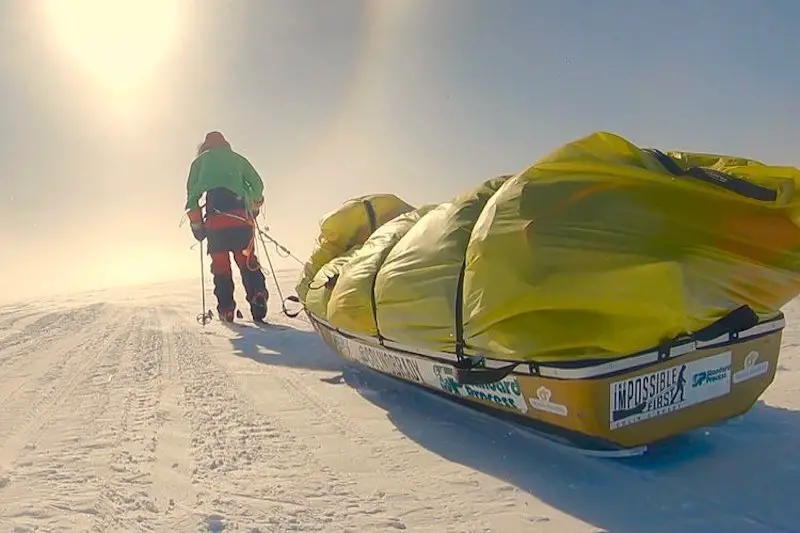Controversy Surrounding O’Brady and Rudd’s Antarctic Crossing: The 2019 Antarctic expeditor season is still a few months off, and while I’m sure we’ll have some interesting stories to follow this year, it will be tough to top the events that took place during the 2018 season. As you may recall, that’s when American Colin O’Brady and the U.K.’s Lou Rudd both made independent crossings of Antarctica, with O’Brady finishing a few days ahead of his counterpart.
In doing so, he claimed to be the first person to have achieved a solo, unsupported, traverse of the continent, with Rudd making a similar claim –– albeit in second place –– shortly thereafter. Their accomplishments were heralded by media across the globe, creating excitement for polar travel even in a mainstream audience. But not long after they wrapped up their journey, controversy set in as a number of explorers stepped forward to challenge O’Brady and Rudd’s claims.
Some took issue with their starting and ending points, some their claims of being “first,” while still others questioned the “unsupported” status. For a time, a heated debate raged through the adventure and exploration community, eventually quieting down as we moved on to other topics. Since then, little new has come to light regarding the topic, that is until now.
Recently, The Outdoor Journal posted a series of stories examining O’Brady and Rudd’s individual expeditions, as well as those of two other major figures in Antarctic exploration. The series is dubbed “Alone Across Antarctica” and it not only takes a close look at the American and Brit’s expeditions,
but also those of Norwegian explorer Børge Ousland and Swiss adventurer Mike Horn. Both Ousland and Horn have completed traverses of Antarctica on their own, both of which were much longer than what Rudd and O’Brady accomplished.
The difference between their journeys is that the Norwegian and Swiss explorer used kites to help them cover longer distances, thus taking away the “unsupported” status. Otherwise, in every way, their expeditions were much more grueling and impressive than O’Brady and Rudd’s.
What sets The Outdoor Journal’s coverage of these events apart is that it not only takes a close look at the four major expeditions in question, it also examines the so-called “rules of adventure” to see where O’Brady and Rudd fall. The biggest claims against them were that they started at the edge of the continent, not the edge of the sea ice, greatly reducing the distance they traveled.
In comparison, O’Brady covered about 900 miles (1448 km) on his crossing, while Ousland traveled more than 3000 miles (4825 km) on his journey. The question here is whether or not Antarctica begins at the edge of the ocean –– and includes glacier ice that is more than 100,000 years old –– or if it starts on the edge of land, which is buried under hundreds of feet of snow and ice.
When Ousland and Horn ended their traverses they were at open ocean for instance, while O’Brady and Rudd stopped when a GPS (and a wooden post) told them to, with no water in sight.
Perhaps even more controversial is the use of the South Pole Overland Traverse (SPOT), a road build by the U.S. to help facilitate travel and the resupply of bases in the Antarctic. O’Brady and Rudd reportedly used that road after departing from the South Pole, saving time and effort, while also not having to navigate. Some see this as a violation of the “unsupported” status, claiming that what the two men accomplished wasn’t on par with Ousland, Horn, and what some others have done.
Most of this isn’t all that new and only serves to reignite the controversy surrounding the story. What is new –– as far as I can tell –– is that O’Brady and Rudd both commented on that controversy for the first time. For instance, Rudd says that while he did follow the SPOT road, it wasn’t a major help. In fact, he says he skied parallel to it because the road itself was rougher to ski on than the regular surface.
He also says that while the SPOT does have navigational aids, he didn’t use them. After two previous expeditions in the Antarctic, he learned the lessons of navigating across the Frozen Continent well and continued to use his compass at all times. O’Brady makes similar claims as well.
If you followed the O’Brady/Rudd story at all last season, not to mention the controversy that followed, then it is worth reading what The Outdoor Journal has put together. It may not change your mind on the subject, but it will certainly provide good perspective. You can start the five-part series here.
- Gear Review: The Xero Scrambler Mid is an Ultralight Hiking Shoe for Spring - March 1, 2023
- Gear Review: Yeti Roadie 48 Wheeled Cooler - August 18, 2022
- Kristin Harila Continues Pursuit of 8000-Meter Speed Record - August 16, 2022
